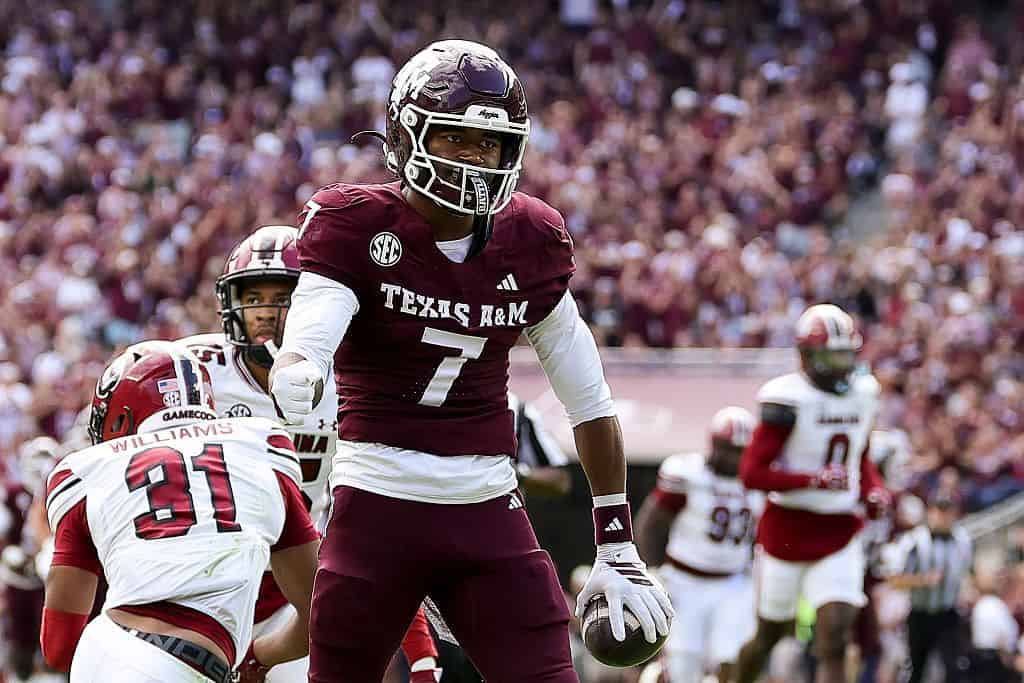This season, I’m breaking down a few of college football's biggest games each week and giving out at least one bet I like from each matchup.
Let’s dive into one of the biggest games of rivalry week as Texas A&M visits Austin to take on the Longhorns for the first time since 2010.
Texas A&M vs. Texas, current line:
Texas A&M at Texas Best Bet Prediction:
The Longhorns have not fared well as an underdog lately, so let's take Texas A&M against the spread.
- Texas A&M vs. Texas, best line: Texas A&M -1.5
» Bet it now at Novig: Texas A&M -1.5 points
When Texas A&M is on Offense
The Aggies run a slightly pass-heavy offense, though it’s a fairly conservative scheme orchestrated by coordinator Collin Klein.
According to Campus2Canton, A&M’s pass rate is 2.6% above expected based on situational data.
Despite the pass-centric offense, the Aggies tend to rely heavily on underneath routes 一 50% of their throws are five or fewer yards downfield 一 which makes it slightly more vulnerable to getting slowed by certain defenses.
Even with the conservative passing attack, the Aggies have been explosive thanks to receivers KC Concepcion and Mario Craver, who are capable of considerable damage after the catch.
The Aggies offense is averaging 20 or more yards on 8.6% of plays, the nation’s 13th-best explosive play rate.
Although Texas has one of the top defenses in the nation, one of its few weaknesses is preventing damage after the catch on shorter throws.
Take a look at how these teams stack up on throws five or fewer yards downfield, via stats from Sports Info Solutions:
- Texas A&M: 7.2 yards per attempt, ranked 4th
- Texas: 5.3 yards per attempt allowed, ranked 69th
- Texas A&M: 10.0 yards per reception, ranked 1st
- Texas: 6.2 yards per reception allowed, ranked 50th
Kentucky and Mississippi State exploited this weakness in the Texas defense most efficiently (no one had more throws of five or fewer yards against Texas this year), and both games were surprisingly competitive.
Check out the stats on those short throws from those two contests:
- Kentucky: 26-29, 185 yards
- Mississippi State: 14-22, 155 yards
Fortunately for Texas, safety Michael Taaffe, who missed the Mississippi State game, is back in action, which helps the Longhorns' ability to defend those types of passes.
However, linebacker Anthony Hill Jr. was out last week, and his status for Friday is uncertain.
A&M’s tendency to get rid of the ball quickly also helps negate Texas’ pass rush, which likely gives the Aggies an edge in that area based on these opponent-adjusted numbers from Sports Info Solutions:
- Texas A&M: ranked 8th in pressure rate allowed
- Texas: ranked 32nd in pressure rate generated
The Longhorn defense is most vulnerable when it can't get consistent pressure due to an inconsistent secondary.
When failing to generate pressure, Texas ranks 66th in completion rate allowed (68%) and 51st in yards per attempt (7.3).
In the run game, the Longhorns are more likely to have an edge based on these opponent-adjusted numbers from Sports Info Solutions:
- Texas A&M: ranked 19th in yards before contact
- Texas: ranked 5th in yards before contact allowed
- Texas A&M: ranked 76th in yards after contact
- Texas: ranked 8th in yards after contact allowed
Since Klein’s offense relies on heavier formations, opposing defenses have been able to stack the box against 63% of rush attempts at the nation’s 20th-highest rate.
That trend further tips the scales in Texas’ favor, as the Longhorns are giving up just 3.3 yards per attempt with a stacked box (ranked 17th) while stopping 27% of those carries for zero or negative yards (ranked 13th).
Fortunately for the Aggies, they should get running back Rueben Owens back (he missed last week’s contest due to injury), and there’s a slight chance Le’Veon Moss could return, as well.
Moss hasn’t played since Week 7, but was the starter through the Aggies' first six games.
In the event neither can play, Amari Daniels would likely make his second start of the season, though the 5-foot-8, 197-pound ball carrier is not the ideal fit for Klein’s scheme.
Texas’ ability to stop the run could prove particularly valuable if it can force A&M into tough down-and-distance situations.
Since the Aggies don’t throw downfield often or with a ton of success, A&M struggles on third and long with a 19% conversion rate, ranked 89th.
Another potential issue for the Aggie offense is penalties.
A&M ranks 115th in penalty yardage per game (64.7), with much of it coming on offensive holding calls (third most in the country).
When Texas is on Offense
Texas runs a pass-heavy offense, throwing the ball at a rate 5.7% above expected based on situational data from Campus2Canton.
The pass-centric approach is in line with Steve Sarkisian’s past tendencies, but even more necessary this season due to an inept run game.
Texas ranks 110th in total rushing yards this year, but there’s a chance the Longhorns could find some success on the ground against the Aggies, which would certainly help Arch Manning and the passing attack.
Let’s check out some opponent-adjusted numbers on the ground game from Sports Info Solutions:
- Texas: ranked 115th in yards before contact
- Texas A&M: ranked 29th in yards before contact allowed
- Texas: ranked 101st in yards after contact
- Texas A&M: ranked 123rd in yards after contact allowed
Those numbers mostly favor A&M, but Sark’s spread scheme could create some issues for the Aggies.
Thanks to Sark’s offensive approach, Texas running backs have faced a light box 61% of the time 一 average is 48%.
That’s problematic for the Aggie run defense, which is allowing 4.2 yards before contact to running backs (ranked 126th) and 6.0 yards per carry (ranked 111th).
Those trends are concerning for the Aggies, but they certainly don’t guarantee success on the ground for Texas.
The worst light-box run defense Texas has faced on its SEC schedule is Florida (ranked 101st in yards per attempt), and Tre Wisner carried the ball eight times for 11 yards in a loss to the Gators.
Although Texas has been more productive in the passing game, there are significant concerns in that area as well.
The biggest issue for the Texas offense has been Manning’s inability to process from the pocket 一 an issue that has shown up consistently in big games due to Sark’s play-calling tendencies.
Take a look at Manning’s numbers on traditional dropbacks (three or more steps), via Sports Info Solutions:
- 54% completion rate, ranked 92nd
- 8.8 yards per attempt, ranked 41st
- 51% pressure rate, ranked 123rd
Now compare that to his numbers on quick dropbacks (zero/one-step drops and RPOs):
- 75% completion rate, ranked 22nd
- 7.6 yards per attempt, ranked 35th
- 18% pressure rate, ranked 34th
An inexperienced quarterback struggling on plays that take longer to develop isn’t uncommon, but it’s noteworthy in this matchup due to Sark’s play-calling tendencies.
When playing with a lead, Manning’s traditional dropback rate is 56%, but it jumps to 69% when the Longhorns are playing from behind.
Sark probably leans on traditional dropbacks when trailing because it's easier to attack downfield and produce explosive plays on those types of play calls, but he’s ignoring Manning’s lack of consistent production.
This trend was an issue just two weeks ago against Georgia, as evidenced by Manning’s numbers from that game:
- Quick dropbacks: 14 of 18, 119 yards, touchdown
- Traditional dropbacks: 12 of 14, 117 yards, interception
And that was against a Georgia defense with a relatively ordinary pass rush 一 the Bulldogs rank 80th in opponent-adjusted pressure rate generated.
So let’s check out the pass protection battle in this game, based on opponent-adjusted numbers from Sports Info Solutions:
- Texas: ranked 111th in pressure rate allowed
- Texas A&M: ranked 18th in pressure rate generated
The Aggies also rank fifth in pressure rate generated against traditional dropbacks (53%).
So while Manning could have success if the Longhorns gain an early lead, the game is likely to spiral out of control (as it did against Georgia) if Texas falls behind early.
Final Thoughts on Texas vs. Texas A&M Best Bets
Although the Longhorn defense could cause some problems for the Aggies, it’s tough to trust Manning to get the job done 一 so let’s play Texas A&M against the spread.
It’s also worth noting that Sark does not fare well as an underdog.
Since arriving at Texas, his team has pulled off just one upset (2023 at Alabama) and is just 2-7 against the spread as an underdog.



















